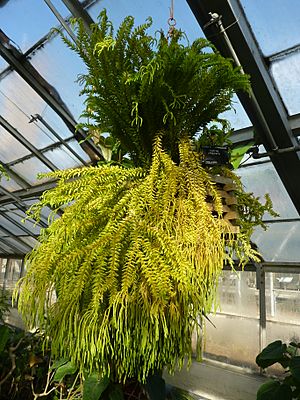Phlegmariurus phlegmaria facts for kids
Quick facts for kids Phlegmariurus phlegmaria |
|
|---|---|
 |
|
| Growing in the Cambridge University Botanic Garden | |
| Conservation status | |
|
Rare (NCA)
|
|
| Scientific classification | |
| Genus: |
Phlegmariurus
|
| Species: |
phlegmaria
|
| Synonyms | |
|
|
Phlegmariurus phlegmaria, also known as the coarse tassel fern or common tassel fern, is a special type of plant. It grows on other plants, like trees, but it doesn't harm them. This plant is found in rainforests across Madagascar, islands in the Indian Ocean, Asia, Australia, and many Pacific Islands. You can often see it in wet forests and rainforests high up, nestled among mosses and other plants that grow on trees. Plants in the group called Lycopodiales are often known as clubmosses.
Contents
About the Tassel Fern
Phlegmariurus phlegmaria is a type of lycophyte, which are plants that have special tissues to carry water and nutrients. This makes them different from simpler plants like mosses. Even though it's called a "tassel fern," it looks a lot like moss.
Plant Structure
This plant has real roots that help it attach to its host tree. Its long stems can hang down up to 80 centimeters (about 31 inches). The leaves grow in a spiral pattern around the stem. They are shaped like a spear, narrow and rounded at the bottom.
The leaves in different parts of the stem look different. The leaves in the "fertile zone" are where the plant makes its spores. These special leaves are called sporophylls. They are shaped like clubs, which is why these plants are often called "clubmosses." Tiny, off-white spores are produced in these club-shaped leaves.
Life Cycle and Spores
The main part of the Phlegmariurus phlegmaria plant that you see is called the sporophyte. This stage is in charge of making spores. These spores are very tiny, about 37 by 35 micrometers. They are released to grow into new plants.
Where It Grows Naturally
You can find Phlegmariurus phlegmaria in many tropical and warm parts of the world.
African Regions
It grows in parts of Africa like Cameroon, Comoros, Equatorial Guinea, Gabon, Ghana, Madagascar, Malawi, São Tomé & Príncipe, Sierra Leone, Tanzania (including Zanzibar Archipelago), and Uganda.
Asian Regions
In Asia, it's found in southern China (in Guangdong, Guangxi, Hainan, Yunnan), southern Japan (like Kyushu and the Ryukyu Islands), Malaysia, Sri Lanka, Taiwan, and Thailand.
Australasian and Pacific Regions
It also lives in Australia (northeast Queensland), New Zealand, and islands in the Pacific like Fiji, Guam, and the Chuuk islands in Micronesia. It might also be found in other warm, tropical places.
Cool Uses of Clubmoss Spores
Many clubmosses, including this one, produce spores that can catch fire easily. Because of this, clubmoss spores have been used for some interesting things throughout history.
- Fireworks: In the past, the outer coating of clubmoss spores was used to make fireworks.
- Photography: Early photographers used these spores in flash powders to create bright flashes of light.
- Fingerprint Powder: They have also been used to make powder for finding fingerprints.
- Medicine: The pharmaceutical industry has used clubmoss spores to coat pills.

